2020版新课标导学高中英语人教版选修八课件:Unit 4 Pygmalion Writing
文档属性
| 名称 | 2020版新课标导学高中英语人教版选修八课件:Unit 4 Pygmalion Writing |  | |
| 格式 | zip | ||
| 文件大小 | 739.2KB | ||
| 资源类型 | 教案 | ||
| 版本资源 | 人教版(新课程标准) | ||
| 科目 | 英语 | ||
| 更新时间 | 2020-02-11 19:58:35 | ||
图片预览

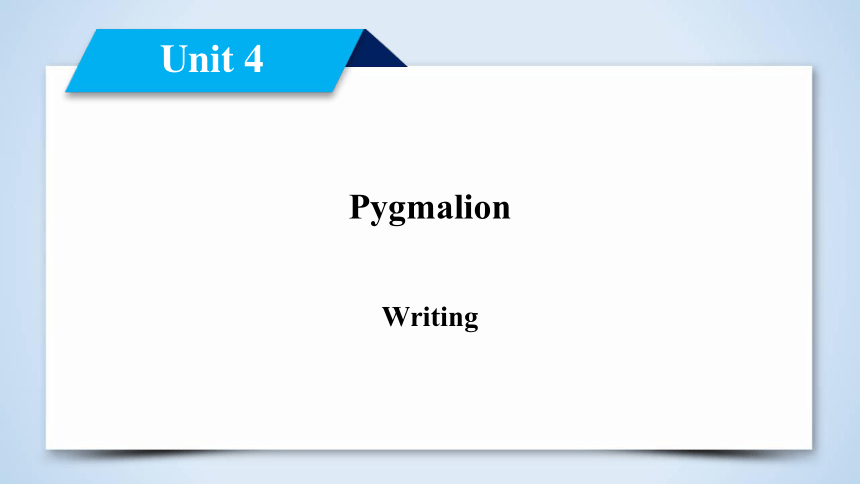
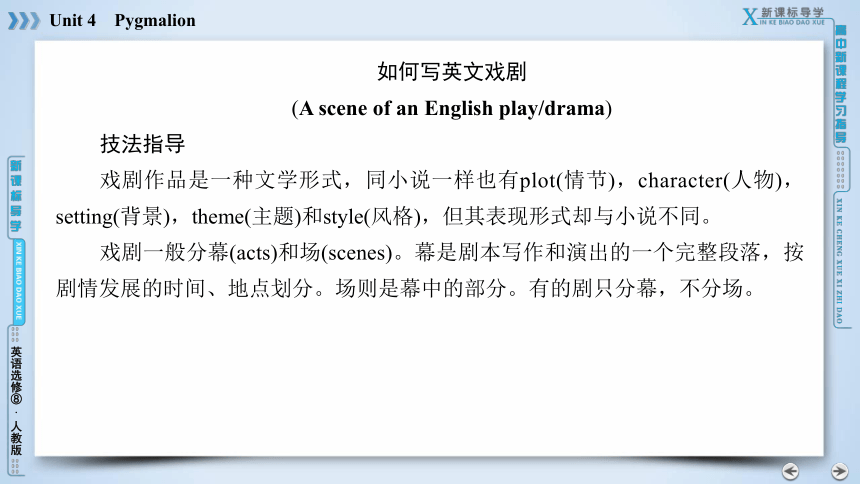
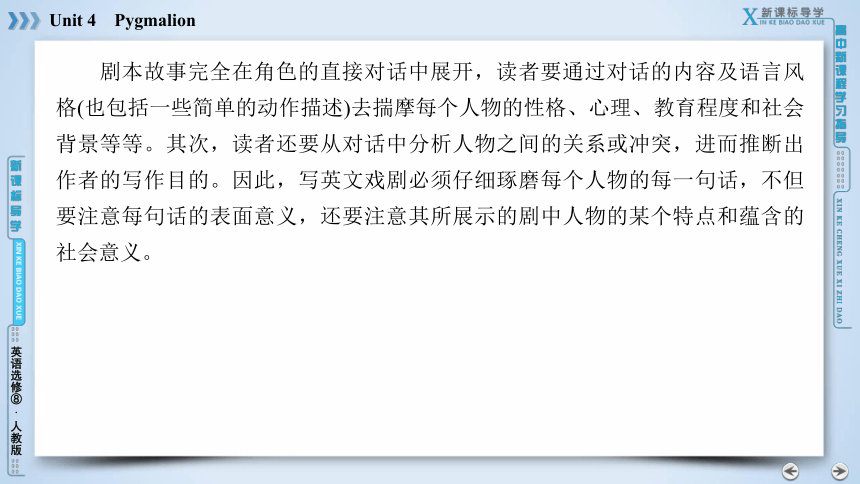
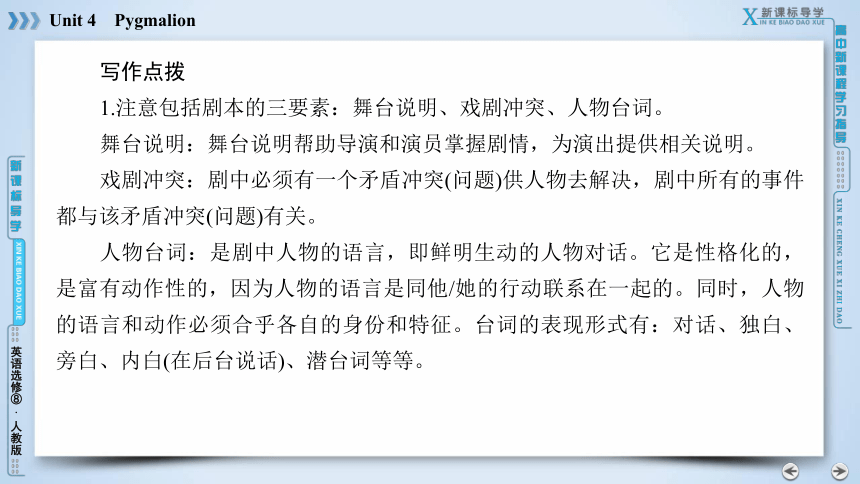
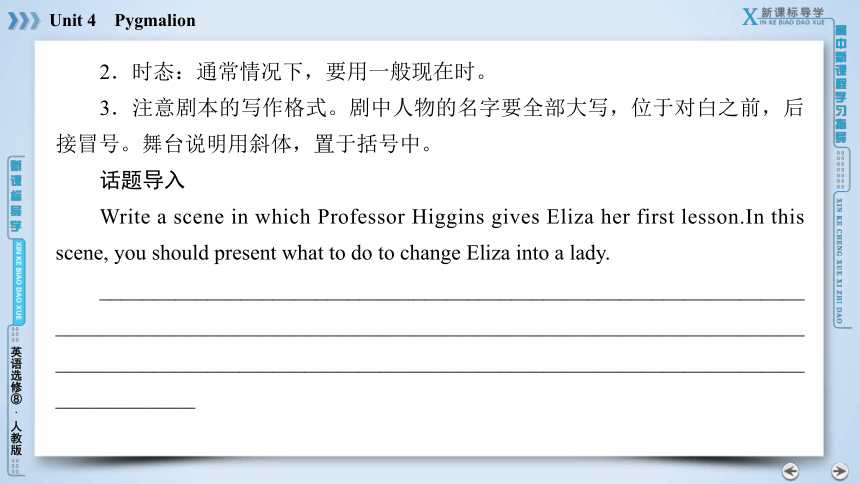
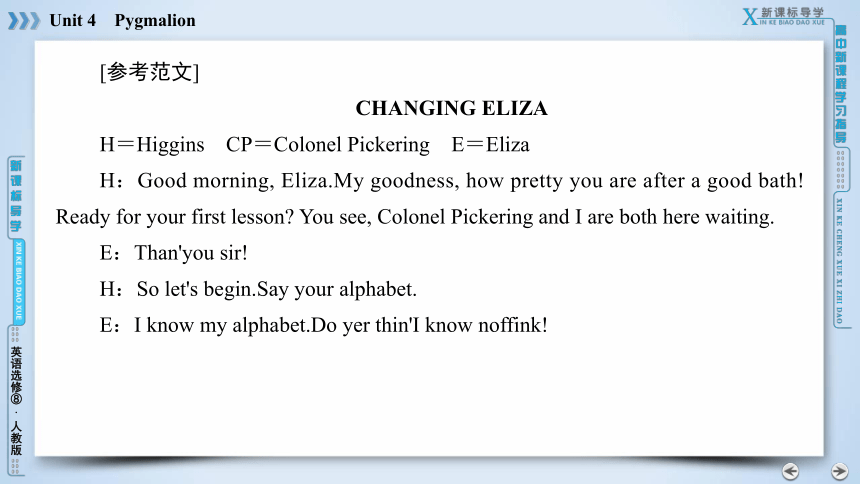
文档简介
课件14张PPT。Unit 4 PygmalionWriting如何写英文戏剧
(A scene of an English play/drama)
技法指导
戏剧作品是一种文学形式,同小说一样也有plot(情节),character(人物),setting(背景),theme(主题)和style(风格),但其表现形式却与小说不同。
戏剧一般分幕(acts)和场(scenes)。幕是剧本写作和演出的一个完整段落,按剧情发展的时间、地点划分。场则是幕中的部分。有的剧只分幕,不分场。剧本故事完全在角色的直接对话中展开,读者要通过对话的内容及语言风格(也包括一些简单的动作描述)去揣摩每个人物的性格、心理、教育程度和社会背景等等。其次,读者还要从对话中分析人物之间的关系或冲突,进而推断出作者的写作目的。因此,写英文戏剧必须仔细琢磨每个人物的每一句话,不但要注意每句话的表面意义,还要注意其所展示的剧中人物的某个特点和蕴含的社会意义。写作点拨
1.注意包括剧本的三要素:舞台说明、戏剧冲突、人物台词。
舞台说明:舞台说明帮助导演和演员掌握剧情,为演出提供相关说明。
戏剧冲突:剧中必须有一个矛盾冲突(问题)供人物去解决,剧中所有的事件都与该矛盾冲突(问题)有关。
人物台词:是剧中人物的语言,即鲜明生动的人物对话。它是性格化的,是富有动作性的,因为人物的语言是同他/她的行动联系在一起的。同时,人物的语言和动作必须合乎各自的身份和特征。台词的表现形式有:对话、独白、旁白、内白(在后台说话)、潜台词等等。2.时态:通常情况下,要用一般现在时。
3.注意剧本的写作格式。剧中人物的名字要全部大写,位于对白之前,后接冒号。舞台说明用斜体,置于括号中。
话题导入
Write a scene in which Professor Higgins gives Eliza her first lesson.In this scene, you should present what to do to change Eliza into a lady.
________________________________________________________________________________________________________________________________________________________________________________________________________________________[参考范文]
CHANGING ELIZA
H=Higgins CP=Colonel Pickering E=Eliza
H:Good morning, Eliza.My goodness, how pretty you are after a good bath! Ready for your first lesson? You see, Colonel Pickering and I are both here waiting.
E:Than'you sir!
H:So let's begin.Say your alphabet.
E:I know my alphabet.Do yer thin'I know noffink!H:Now, now! Let's start again.Say this after me.(very slowly, loudly and carefully) Do you think I don't know anything?
E:Do yer think I don't know anything!
CP:Do you know, Higgins, I think that was better!
H:(far from satisfied) Once more, Eliza.(emphasizing each word) Do you think I don't know anything!
E:(very slowly and carefully too) Do you think I don't know anything?
H:Now to the alphabet, my girl.Don't argue—just say it.CP:Yes, say it, Eliza! You'll understand soon.Do what he tells you and let him teach you in his own way.
E:Oh, well! If you put it like that! Ahyee, Bayee, Sayee, Dayee...
H:(bored) Stop at once.Now say A,B,C, and D.
E:(in tears) But I am saying it.Ahee, Bayee, Sayee, Dayee...
H:Stop! Say “a cup of tea”.
E:I cap-o-tee.
H:Put your tongue forward until it pushes against the top of your lower teeth.Now say“cup”.
E:C-c-c.I can't.I can't hear no difference'cept that it sounds more genteel—like when you say it.(begins to cry)H:(angrily)Well, if you can hear that, why are you crying? Now try again, Eliza.
E:C-cup.
CP:Splendid,Miss Doolittle.Never mind a little crying, you are doing very well.The lessons won't hurt.I promise not to let him pull you round by your hair.
H:Now try the whole thing.Eliza.A cup of tea.
E:(very slowly and with emphasis)A cu-up of tea.
CP:Good, good!
H:Better,better! Now try this sentence.“The rain in Spain falls mainly on the plain”.E:(again with emphasis)The fine in Spine falls minely on the pline.
H:(excitedly) It's coming ! It's coming ! Now try again, Eliza.(slowly) The rain (ai, ai, ai) in Spain (ai, ai, ai) falls mainly on the plain.
E:The rai-ain in Spai-ain falls mai-ainly on the plain.
CP:Miss Doolittle, that's so much better.
H:Now, Eliza,go and practise by yourself.Keep your tongue well forward instead of trying to swallow it.
E:(beginning to cry) Oah ! Oah !
H:(angrily) Now Eliza, go and tell Mrs Pearce about this lesson.Think about it and practise by yourself.Away with you!
(Eliza is still sobbing,rushes from the room)
CP:Now Henry,couldn't you have been kinder to that poor girl after all the effort she made?[名师点评]
1.本文写了戏剧的一场,在这短短的一段中舞台说明明确,通过口语化的台词展示了Eliza向Higgins学习的片段,想象比较合理,符合戏剧写作的格式。
2.舞台说明通过very slowly and carefully too, in tears very slowly and with emphasis, again with emphasis, beginning to cry等,充分体现了Eliza在第一次学习发音时的小心,因发音不对受到训斥时的难过、委屈,再次练习时的努力,谨慎等学习心态的变化,符合人物的身份、特点。
(A scene of an English play/drama)
技法指导
戏剧作品是一种文学形式,同小说一样也有plot(情节),character(人物),setting(背景),theme(主题)和style(风格),但其表现形式却与小说不同。
戏剧一般分幕(acts)和场(scenes)。幕是剧本写作和演出的一个完整段落,按剧情发展的时间、地点划分。场则是幕中的部分。有的剧只分幕,不分场。剧本故事完全在角色的直接对话中展开,读者要通过对话的内容及语言风格(也包括一些简单的动作描述)去揣摩每个人物的性格、心理、教育程度和社会背景等等。其次,读者还要从对话中分析人物之间的关系或冲突,进而推断出作者的写作目的。因此,写英文戏剧必须仔细琢磨每个人物的每一句话,不但要注意每句话的表面意义,还要注意其所展示的剧中人物的某个特点和蕴含的社会意义。写作点拨
1.注意包括剧本的三要素:舞台说明、戏剧冲突、人物台词。
舞台说明:舞台说明帮助导演和演员掌握剧情,为演出提供相关说明。
戏剧冲突:剧中必须有一个矛盾冲突(问题)供人物去解决,剧中所有的事件都与该矛盾冲突(问题)有关。
人物台词:是剧中人物的语言,即鲜明生动的人物对话。它是性格化的,是富有动作性的,因为人物的语言是同他/她的行动联系在一起的。同时,人物的语言和动作必须合乎各自的身份和特征。台词的表现形式有:对话、独白、旁白、内白(在后台说话)、潜台词等等。2.时态:通常情况下,要用一般现在时。
3.注意剧本的写作格式。剧中人物的名字要全部大写,位于对白之前,后接冒号。舞台说明用斜体,置于括号中。
话题导入
Write a scene in which Professor Higgins gives Eliza her first lesson.In this scene, you should present what to do to change Eliza into a lady.
________________________________________________________________________________________________________________________________________________________________________________________________________________________[参考范文]
CHANGING ELIZA
H=Higgins CP=Colonel Pickering E=Eliza
H:Good morning, Eliza.My goodness, how pretty you are after a good bath! Ready for your first lesson? You see, Colonel Pickering and I are both here waiting.
E:Than'you sir!
H:So let's begin.Say your alphabet.
E:I know my alphabet.Do yer thin'I know noffink!H:Now, now! Let's start again.Say this after me.(very slowly, loudly and carefully) Do you think I don't know anything?
E:Do yer think I don't know anything!
CP:Do you know, Higgins, I think that was better!
H:(far from satisfied) Once more, Eliza.(emphasizing each word) Do you think I don't know anything!
E:(very slowly and carefully too) Do you think I don't know anything?
H:Now to the alphabet, my girl.Don't argue—just say it.CP:Yes, say it, Eliza! You'll understand soon.Do what he tells you and let him teach you in his own way.
E:Oh, well! If you put it like that! Ahyee, Bayee, Sayee, Dayee...
H:(bored) Stop at once.Now say A,B,C, and D.
E:(in tears) But I am saying it.Ahee, Bayee, Sayee, Dayee...
H:Stop! Say “a cup of tea”.
E:I cap-o-tee.
H:Put your tongue forward until it pushes against the top of your lower teeth.Now say“cup”.
E:C-c-c.I can't.I can't hear no difference'cept that it sounds more genteel—like when you say it.(begins to cry)H:(angrily)Well, if you can hear that, why are you crying? Now try again, Eliza.
E:C-cup.
CP:Splendid,Miss Doolittle.Never mind a little crying, you are doing very well.The lessons won't hurt.I promise not to let him pull you round by your hair.
H:Now try the whole thing.Eliza.A cup of tea.
E:(very slowly and with emphasis)A cu-up of tea.
CP:Good, good!
H:Better,better! Now try this sentence.“The rain in Spain falls mainly on the plain”.E:(again with emphasis)The fine in Spine falls minely on the pline.
H:(excitedly) It's coming ! It's coming ! Now try again, Eliza.(slowly) The rain (ai, ai, ai) in Spain (ai, ai, ai) falls mainly on the plain.
E:The rai-ain in Spai-ain falls mai-ainly on the plain.
CP:Miss Doolittle, that's so much better.
H:Now, Eliza,go and practise by yourself.Keep your tongue well forward instead of trying to swallow it.
E:(beginning to cry) Oah ! Oah !
H:(angrily) Now Eliza, go and tell Mrs Pearce about this lesson.Think about it and practise by yourself.Away with you!
(Eliza is still sobbing,rushes from the room)
CP:Now Henry,couldn't you have been kinder to that poor girl after all the effort she made?[名师点评]
1.本文写了戏剧的一场,在这短短的一段中舞台说明明确,通过口语化的台词展示了Eliza向Higgins学习的片段,想象比较合理,符合戏剧写作的格式。
2.舞台说明通过very slowly and carefully too, in tears very slowly and with emphasis, again with emphasis, beginning to cry等,充分体现了Eliza在第一次学习发音时的小心,因发音不对受到训斥时的难过、委屈,再次练习时的努力,谨慎等学习心态的变化,符合人物的身份、特点。
